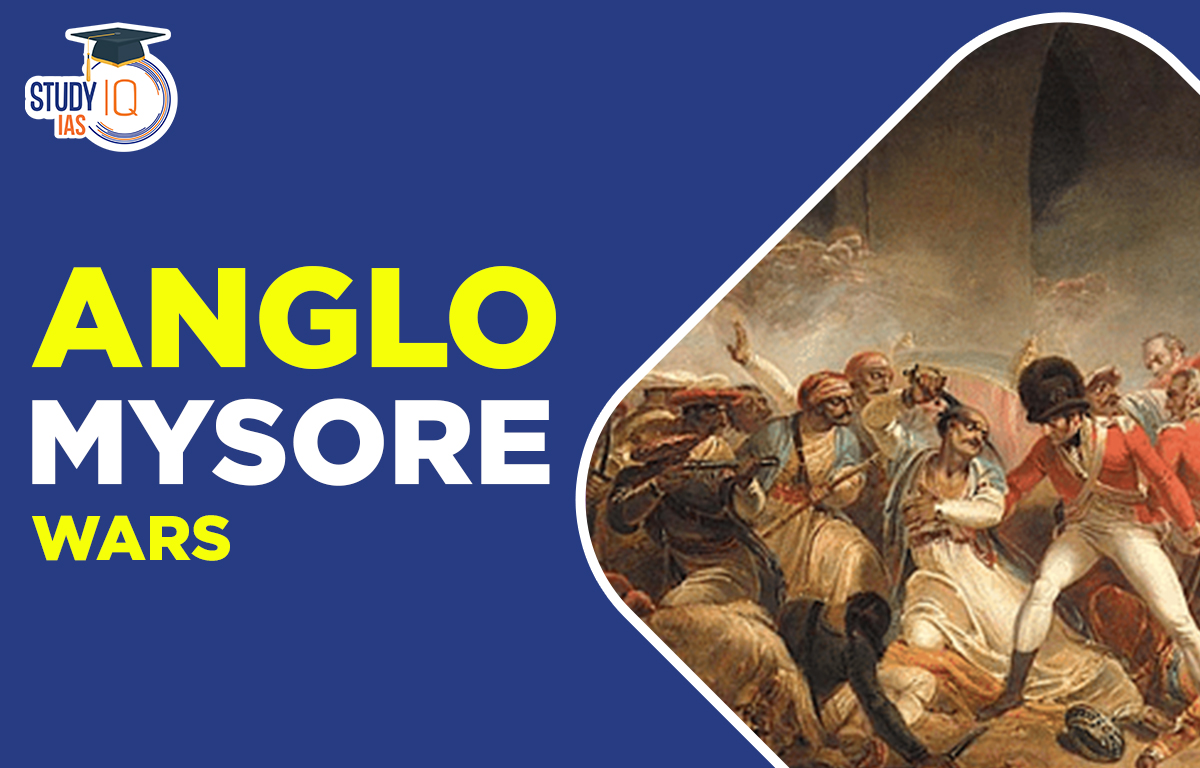Table of Contents
Anglo Mysore War
Anglo Mysore Wars is a series of four military Wars between the British and the rulers of Mysore in India engaged known as the Anglo Mysore Wars. 1767 was the start of the first Anglo-Mysore War, which lasted until 1799. The East India Company repeatedly attempted to topple the Mysore Empire in south India during this turbulent time of British rule in India. British rule had already advanced over north India, but unexpected resistance came from Haider Ali, the king of the Mysore Empire, when the British attempted to unite India as a nation.
The Anglo-Mysore War is a significant topic in the Indian history section of the UPSC GS II exam and is related to the history of the Indian kings. Over the years, UPSC has frequently asked questions about the Anglo-Mysore War in the test. The circumstances that led to the first and second Mysore Wars must be current.
Read about: Battle of Buxar
First Anglo Mysore War
The First Anglo-Mysore War (1766–1769) was fought in India between the East India Company and the Sultanate of Mysore. After their easy win in Bengal, the English felt confident in their military might. In 1766, they made a deal with the Nizam of Hyderabad, pledging to give them the Northern Circars in return for defending him from Haidar Ali.
1. First Anglo Mysore War History
The British had not only created somewhat solid bases in Bombay, Madras, and Calcutta by the time of the Third Carnatic War (1757–1763), but they had also diminished, but not quite eliminated, the supremacy of other colonial powers. Treaties with Muhammed Ali Khan Wallajah, the Nawab of Carnatic, whose territory surrounded Madras, had a big influence on their eastern holdings at Madras.
The other major powers in the east were the Sultanate of Mysore, which occupied the high plains between the Eastern and Western Ghats, the mountain ranges separating India’s coastal plains from the interior, and the Nizam of Hyderabad, which was formerly a viceroyalty of the Mughal Empire but declared independent in the 1720s and held by Asaf JahII in the 1760s.
After their straightforward victory in Bengal, the English were confident in their military might. They made a pact with the Nizam of Hyderabad (1766), promising to defend him from Haidar Ali in exchange for him giving them the Northern Circars (region). Haidar and the Nawab of Arcot already had territorial disputes in addition to disputes with the Marathas.
To combat Haidar Ali, the English, Marathas, and the Nizam banded together. Haidar acted delicately and diplomatically. In order to neutralise the Marathas, Haidar Ali offered to divide the territory he had taken with the Nizam in exchange for the Nizam’s help. The Nizam then invited him to assist him in his attack on the Nawab of Arcot.
2. First Anglo Mysore War Courses
The Marathas attacked northern Mysore in January 1767, most likely anticipating nizam operations, and this started the battle. When Haider decided to stop the attack, they moved as far south as the Tungabhadra River. The Marathas then reversed direction. The Nizam then used an English force to help launch an attack on Mysore. The attack, however, was not totally successful.
The Nizam betrayed the English and allied himself with Haider Ali in September 1767. The combined forces of their armies proved too strong for Smith, the English commander, and he was forced to retreat to Trichinopoly, where Colonel Wood joined him. The conflict at Trichinopoly between the Nizam and Haider Ali was unsuccessful, and Haider Ali was defeated elsewhere in December 1767.
In March 1768, the English planned to invade Hyderabad, which killed the Nizam’s spirit. Nizam thus gave the English Diwani of Mysore permission. The English and Haider Ali became sworn enemies as a result of this arrangement. The pact also resulted in Haider Ali being without an ally. In contrast, he maintained his fearlessness. After defeating an English force sent from Bombay, he took control of Mangalore. On April 4, 1769, he forced the English to sign a treaty after storming Madras in March.
3. First Anglo Mysore War Result
For an additional year and a half, there was no sign of an end to the conflict. Haidar changed his course and made it to the gates of Madras. The Pact of Madras, a humiliating treaty with Haidar, was signed by the English on April 4, 1769, as a result of the complete chaos and dread that day in Madras. In accordance with the contract, captives were exchanged, and conquests were reciprocally returned. The English agreed to help Haidar Ali if he was assaulted by another force.
4. Anglo Mysore and Treaty of Madras
The First Anglo-Mysore War was put an end by the Treaty of Madras, which was signed on April 4, 1769, between Mysore and the British East India Company (Lord Harry Verelst). Fighting broke out in 1767, and Hyder Ali’s army came perilously near to capturing Madras. The British were bound by the Treaty to assist Hyder Ali if he was attacked by his neighbours.
Hyder believed the agreement had been broken when Mysore and the Marathas went to war in 1771 because he received no support. The Second Anglo-Mysore War may have started ten years later as a result of the loss of trust brought on by the clause that was broken.
Read about: Carnatic War
Second Anglo Mysore War
The Kingdom of Mysore and the British East India Company engaged in combat during the Second Anglo-Mysore War, which took place between 1780 and 1784. Anglo-Mysorean wars in India were caused by the conflict in the American Revolutionary War between Britain, the French, and the Dutch, as Mysore was an important French ally in India at the time.
1. Second Anglo Mysore War History
In 1771, when Haidar Ali was under Maratha attack and the English did nothing to aid him, he accused them of breaking their word and disregarding the Treaty of Madras. Furthermore, he found that the French were much more helpful than the English in providing his troops with weapons, saltpetre, and lead.
As a result, Mahe, a French colony on the Malabar Coast, served as a conduit for the delivery of some French military equipment to Mysore. The French joined the rebels in their fight against the English during the American Revolutionary War, which had already broken out. The French affinities of Haidar Ali further frightened the English under these circumstances.
As a result, they made an attempt to capture Mahe, whom Haidar believed to be in his care. Haidar perceived the English attempt to annex Mahe as a direct threat to his authority. Haidar established a coalition against the British that included the Marathas and the Nizam of Hyderabad in addition to the French.
2. Second Anglo Mysore War Courses
Haidar forged an anti-English alliance with the Marathas and the Nizam. Invading the Carnatic in 1781, he captured Arcot and routed Colonel Baillie’s English forces. In the meantime, the English (under Sir Eyre Coote) expelled the Marathas and the Nizam from Haidar’s side, but the unmoved Haidar faced out against the English and lost at Porto Novo in November 1781.
But after reorganising his troops, he routed the English and captured their captain, Braithwaite. Haidar Ali passed away from cancer on December 7, 1782. Tipu Sultan, his son, carried on the struggle for another 12 months without any real progress. Company representatives were instructed to stop the fighting and start talking to Tipu during this period by the company’s London headquarters.
When a preliminary cease-fire was declared, Colonel Fullarton was told to hand over every victory he had just achieved. At contrast, Fullarton remained in Palghatcherry because of rumours that Tipu had violated the terms of the cease-fire in Mangalore. On January 30, Tipu Sultan received the garrison of Mangalore.
3. Second Anglo Mysore War Result
A treaty was signed at Mangalore, India, and is known as the Treaty of Mangalore. Haidar Ali’s life died of cancer on December 7, 1782. For a full year, Tipu Sultan, his son, carried on the struggle unsuccessfully. After a struggle that had no clear winner, both sides sought peace, leading to the signing of the Treaty of Mangalore in March 1784, which required each side to return the area it had taken from the other.
It was the second of four Anglo-Mysore Wars, and as a result, the British came to rule the majority of southern India. The terms of the Treaty of Mangalore prevented the British from intervening in the 1785 conflict between Mysore and its neighbours, the Maratha Empire and the Nizam of Hyderabad.
4. Second Anglo Mysore War and Treaty of Mangalore
The Treaty of Mangalore was inked on March 11, 1784, by Tipu Sultan and the British East India Company. The peace treaty that was signed at Mangalore marked the end of the Second Anglo-Mysore War. The Treaty of Mangalore was widely viewed in Britain as the British East India Company’s demise. The British East India Company suffered as a result, and the business started to fall apart.
A sixth of the nation’s overall income came from commerce; hence the British government was quite concerned about this. By passing what is now referred to as Pitt’s India Act, it was decided to remedy the problems. This legislation addressed the problem of corruption and granted the Governor-General the power to act in the King’s and the nation’s interests to avoid a repetition of the Treaty of Mangalore.
Read about: Battle of Plassey
Third Anglo-Mysore War
The Kingdom of Mysore, the British East India Company, the Maratha Empire, and the Nizam of Hyderabad engaged in combat during the Third Anglo-Mysore War (1790–1792) in South India. When Cornwallis was appointed governor-general of the Company and came in India, the third battle between the English and Mysore took place. Tipu opposed the English with fiercely.
1. Third Anglo-Mysore War History
Tipu had several complaints against the Travancore kings, who were an English ally and dependent on them. Travancore had acquired Jalkottal and Cannanore from the Dutch in the state of Cochin. Tipu considered Travancore’s conduct to be an invasion of his sovereign rights because Cochin was Tipu’s feudatory. In order to restore his rights, Tipu launched a war against Travancore in April 1790.
Before declaring war on Tipu, Cornwallis exercised extreme caution. Both the Marathas and the Nizam of Hyderabad were in conversation with him. The Marathas negotiated agreements with the English in June 1790 and the Nizam in July 1790. Both made the decision to support the English in their conflict with Tipu. The three allies also agreed to divide the conquered territory among them.
Despite the fact that the English endured the most of the suffering of the conflict, they were assured that Tipu would be left alone to confront them. In response, the English went to war with Tipu in 1790.
2. Third Anglo-Mysore War Courses
In their conflict with Mysore, the British sided with Travancore. The Nizam and the Marathas, who were outraged by Tipu’s growing power, joined the British. British troops under General Meadows were defeated by Tipu Sultan in 1790. The initial English assault was conducted, but it was unsuccessful. Tipu spent two years fighting the battle by himself.
As a result, Cornwallis took over as army commander in December 1790. He invaded Bangalore in March 1791 and conquered it. The English were forced to retreat during the rainy season as a result of Tipu’s courageous fighting. In November 1791, Tipu won in Coimbatore. But his strength was exhausted. Cornwallis overcame every hill fort that stood in his way of getting to the outer wall of Srirangapatnam.
Tipu started negotiating with the English out of desperation. The Treaty of Srirangapatnam was signed in March 1792 owing to Cornwallis’ approval.
3. Third Anglo Mysore War Result
The conflict was put an end by the Treaty of Seringapatam, signed in 1792. Under the terms of this agreement, the British, Nizam, and Marathas jointly annexed roughly half of Mysorean territory. The Nizam was given the region from Krishna to beyond the Pennar, while the Marathas were given the regions surrounding the Tungabhadra and its tributaries. The British were given Baramahal, Dindigul, and Malabar. Tipu was also accused of causing war damage worth three crore rupees.
In exchange for paying half of the war indemnity immediately and the other half in instalments, the English abducted Tipu’s two sons as hostages. The Third Anglo-Mysore War, which solidified British rule there, undercut Tipu’s strong position in the south.
4. Third Anglo Mysore War and Treaty of Seringapatam
On March 18, 1792, the Treaty of Srirangapatna, also known as Srirangapatinam or Srirangapatna, was signed. Charles Cornwallis of the British East India Company, the Nizam of Hyderabad, the Maratha Empire, and Tipu Sultan, the sultan of Mysore, all signed it. According to the terms of the treaty, Mysore gave up nearly half of its land to the other signatories.
The Nizam received land from the Krishna to the Penner River as well as the forts of Cuddapah and Gandikota on the south bank of the Penner River, while the Maratha received territory up to the Tungabhadra River. The districts of Baramahal and Dindigul, as well as a significant portion of the Malabar Coast region of Mysore between the Kingdom of Travancore and the Kali River, were ceded to the East India Company. Coorg was given to the monarch of Mysore, but it quickly turned into a corporate dependency.
Fourth Anglo-Mysore War
Between the Kingdom of Mysore and the British East India Company and the Deccan, the Fourth Anglo-Mysore War took place in South India in 1798–1799 The fourth and last of the four Anglo-Mysore Wars was this one. The British took control of Mysore’s capital. The struggle resulted in the death of the king, Tipu Sultan. The Wadiyar family was restored to the king after Britain indirectly took control of Mysore.
1. Fourth Anglo-Mysore History
To make up for their losses, Tipu Sultan and the English took advantage of the years 1792–1799. Tipu freed his sons after meeting all the requirements of the Treaty of Seringapatam. When the Hindu Wodeyar dynasty’s king passed away in 1796, Tipu refused to crown Wodeyar’s young son and proclaimed himself Sultan instead.
He also vowed to exact revenge for both the terms of the Treaty of Seringapatam and his humiliating defeat. Lord Wellesley succeeded Sir John Shore as governor general in 1798. Tipu’s growing sympathy for the French alarmed Wellesley, an imperialist at heart, who tried to eliminate Tipu’s autonomous existence or force him to capitulate using the Subsidiary Alliance system.
Tipu was accused of plotting against the English with the Nizam and the Marathas and of sending treasonous agents to Arabia, Afghanistan, Kabul, Zaman Shah, the Isle of France (Mauritius), and Versailles. Wellesley didn’t find Tipu’s explanation to be satisfactory.
2. Fourth Anglo-Mysore Courses
In 1798, Lord Wellesley, a fervent imperialist, succeeded Sir John Shore as Governor-General. During the combat, rockets were used on several occasions. One of them involved Colonel Arthur Wellesley, later known as the First Duke of Wellington. Wellesley was defeated by Tipu’s Diwan, Purnaiah, at the Battle of Sultanpet Tope.
Wellesley was worried about the growing relations Tipu was developing with France. He forced Tipu into submission through the Subsidiary Alliance framework with the intention of eradicating Tipu’s autonomous existence. On April 17, 1799, hostilities erupted, and on May 4, 1799, Seringapatam fell. Both British General Stuart and General Harris conquered Tipu. Arthur Wellesley, Lord Wellesley’s brother, also participated in the conflict.
The Nizam and the Marathas once again sided with the British because the Nizam had previously joined the Subsidiary Alliance and the Marathas had been given half of Tipu’s territories. The British seized all of Tipu Sultan’s fortune after his death during the conflict. The British chose a son from the previous Hindu royal line of Mysore to serve as the maharaja and imposed the subsidiary alliance system on him.
It had taken the English 32 years to conquer Mysore. The Deccan effectively lost the chance of experiencing a French Renaissance. A British bullet struck a rocket magazine within Tipu Sultan’s fort on May 2, 1799, during the decisive British assault on Seringapatam, causing it to explode and send a towering cloud of black smoke and cascades of brilliant white light leaping up from the battlements.
3. Fourth Anglo Mysore War Result
The English Generals Stuart and Harris twice conquered Tipu. Arthur Wellesley, the brother of Lord Wellesley, served in the military as well. The English were once more helped by the Marathas and the Nizam. The Marathas received half of Tipu’s land, and the Nizam had already joined the Subsidiary Alliance.
Tipu died bravely in battle; his family was imprisoned in Vellore; and the English took his belongings. The subsidiary alliance system was enforced on the child of the erstwhile Hindu royal line of Mysore who was made maharaja by the English. The youthful successor of Tipu Sultan, Fateh Ali, was banished. The Kingdom of Mysore became a princely state and ceded Coimbatore, Dakshina Kannada, and Uttara Kannada to the British as part of a secondary alliance with British India encompassing regions of modern-day Kerala-Karnataka.
The newly established princely kingdom of Mysore was entirely governed by the British Empire, as well as a subsidiary alliance (the Subsidiary Treaty signed on 6 April 1801). The British might interfere with empire governance as well. The fourth Mysore war led to the British gaining complete control and domination over South India. After the war, the British government granted Lord Wellesley the title of Marquee.
Anglo Mysore War UPSC
An essential part of the UPSC curriculum for the IAS Exam preparation is the Anglo-Mysore War. The history of the Indian emperors, which includes significant occurrences, influences, and uprisings that contributed to the Anglo-Mysore Wars, should be included in the curriculum.
The East India Company’s participation and the numerous treaty violations that caused the four wars are also important aspects of this subject. For a high IAS test result, it’s also crucial to frequently consult literature on Indian politics and history. To improve your preparation, you can also consult the currently accessible UPSC study guides and past years test questions.
Anglo Mysore War FAQs
Q) How many wars did Anglo Mysore have?
Ans. Mysore Wars, four military confrontations (1767–69; 1780–84; 1790–92; and 1799) in India between the British and the rulers of Mysore.
Q) Who won 3 Anglo Mysore War?
Ans. British won 3 Anglo Mysore War
Q) Who won 2 Anglo Mysore War?
Ans. It was the second of four Anglo-Mysore Wars, which ultimately ended with British control over most of southern India.
Q) Who won the first battle of Anglo Mysore?
Ans. The British and Mysore fought a total of four wars. The Anglo-Mysore wars were referred to as such. Hyder Ali won the first Anglo-Mysore war by defeating the British.
Q) Who won 4 Anglo-Mysore war?
Ans. The Mysorean capital was taken by the British. In the conflict, the monarch Tipu Sultan was killed. The Wadiyar dynasty was reinstated to the Mysore crown when Britain assumed indirect control of the city.


 Nagari Pracharini Sabha Revival: Backgro...
Nagari Pracharini Sabha Revival: Backgro...
 Ryotwari System in India, Features, Impa...
Ryotwari System in India, Features, Impa...
 Battle of Plassey, History, Causes, Impa...
Battle of Plassey, History, Causes, Impa...





















